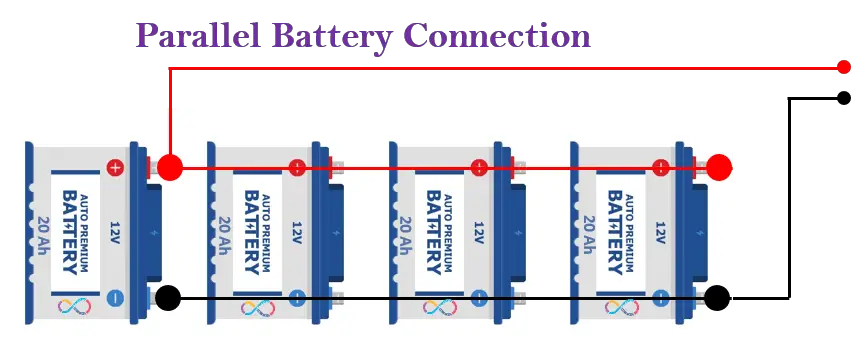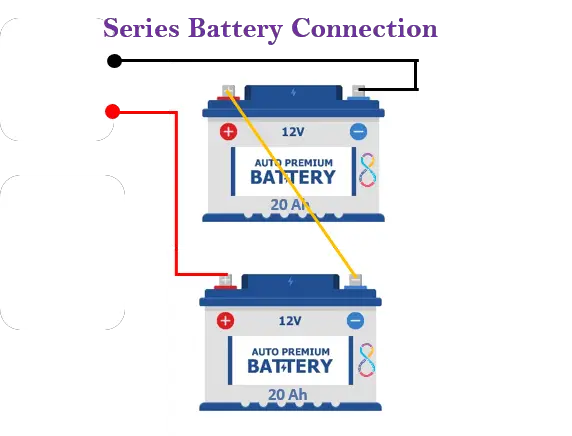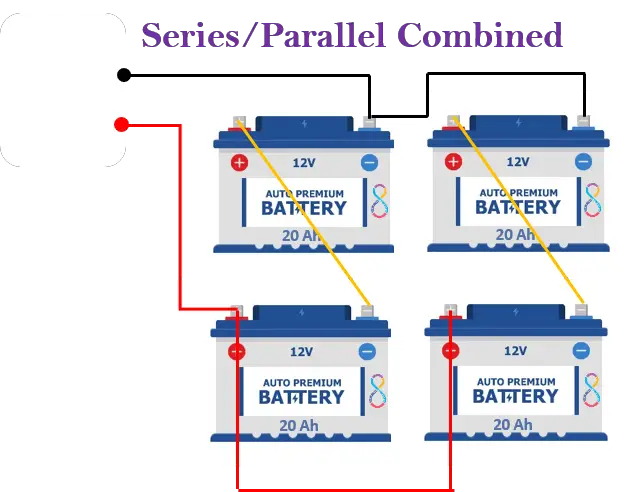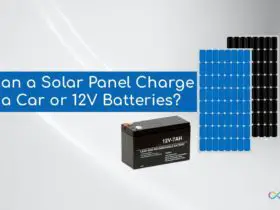Connecting batteries or cells is often required when you want to increase the voltage or amperage or both for various applications. By connecting batteries together – Series, Parallel, and Series/Parallel combined, you are constructing what’s called a battery bank which gives you more power for your applications.
There are 3 methods for connecting batteries and constructing a battery bank: Series, Parallel, and Series/Parallel Combined. We will describe each method briefly using illustrations to give you a clear concept.
What do you need to know before connecting batteries together?
Before constructing a battery bank, make sure that you follow the tips below:
- Use batteries specifically designed for solar energy storage
- Have batteries of the same size (same voltage and same amperage ratings)
- Don’t mix an old battery (weak) with a new one (causes charging imbalance)
- Don’t use a typical 12v lead-acid car battery, however, you can use an electric vehicle’s lithium-ion battery if you no longer need it
#1 Parallel Battery Connection – Increasing Amperage (capacity)
A parallel battery connection is used when you want to increase the amperage (capacity) and keep the voltage the same. Let’s explain this method with an example!
This method is used when you want your application to run longer between charging. The voltage remains unchanged in a parallel battery connection. In the illustration below, you can see 4 batteries connected in parallel, the positive (+) terminal of the first battery is connected with the positive (+) terminal of the second battery… till the end, and the negative (-) terminal of the first battery is connected with the negative (-) terminal of the second battery and so on.

The connection will result in 12V, 80Ah capacity. As the amperage is increased to 80Ah you may need a heavy-duty cable to keep the cable from burning out. The parallel connection needs at least 2 batteries. When connecting batteries in parallel you will need a jumper wire to connect all positive (+) terminals and another jumper wire to connect negative (-) terminals.
The preferred method for keeping the batteries equalized is to connect to the positive (+) at one end of the battery pack, and the negative (-) at the other end of the pack, as illustrated in the figure above.
#2 Series Battery Connection – Increasing Voltage
You will need this configuration when you need to increase the overall voltage of the system. In series battery connection voltage adds and amperage rating (also known as Amp Hours) remains unchanged. Let’s explain this method with an example!
For this method, you will need at least two batteries of the same size and rating. Connecting in series battery configuration is when you combine two or more batteries by linking the positive (+) terminal of the first battery with the negative (-) terminal of the second battery. If only two batteries were used then you would have a cable coming off the negative (-) terminal of the first battery to your application and a cable coming off the positive (+) terminal on the second battery heading to the application, as illustrated in the figure below.

This connection will result in 24V, 20Ah capacity. Next, we will explain another way to increase both the voltage and amperage rating. This may sound confusing but we will explain below.
#3 Series/Parallel Combined Battery Connection – Increasing Both Voltage and Amperage
To connect batteries in series/parallel combined connection, you will need at least 4 batteries of the same size and rating. Let’s explain this with an example!
You will have two or more banks of batteries in series/parallel battery configurations. Each bank of batteries will combine batteries configured in series to the desired voltage. The banks will then be connected together in parallel to increase the total system capacity as illustrated in the figure below.

This connection will result in 24V, 40Ah capacity. A combined connection is like you are combining two identical battery banks together.
Which Battery Connection Method Shall I Choose?
You can connect as many batteries together as you want but when you start to construct a tangled mess of batteries and cables can be very confusing, and confusion can be dangerous. The answer to this question depends on the application. Keep in mind the requirements for your application, and stick to them. Also, use batteries of the same rating. Avoid mixing and mismatching battery sizes wherever possible.
You can also use these connections for recharging the batteries through solar panels. While constructing a battery bank, always ensure your safety, and keep track of your battery connections. If it helps, make a diagram of your battery banks before attempting to construct them.




![Types of Engineers and What they Do [Explained]](https://www.engineeringpassion.com/wp-content/uploads/2022/04/types-of-engineers-and-what-they-do-280x210.jpg)








Leave a Reply